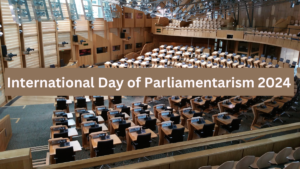Table of Contents
The World Hemophilia Day is observed every year on April 17th to bring peoples attention towards Hemophilia and other bleeding disorders. This day honors the birthday of WFH founder Frank Schnabel. This year’s theme for the World Hemophilia Day is, “Access for All: Women and Girls Bleed Too”. This Article explores the Theme, Support & Awareness and the history of this day in detail.
World Hemophilia Day 2025 Theme
Every Year, the World Hemophilia Day has a different theme. The theme for the year 2025 is “Access for All: Women and Girls Bleed Too” emphasizing the need for better diagnosis and treatment for women and girls with bleeding disorders, who often remain underdiagnosed and underserved. This theme was chosen to promote early recognition, accurate diagnosis, effective treatment, and compassionate care, to elevate the quality of life for those affected and strengthen the bleeding disorders community.
What is Hemophilia?
Hemophilia is a rare genetic bleeding disorder in which the blood doesn’t clot properly due to a lack of certain clotting factors. This condition can lead to prolonged bleeding after injuries, surgeries, or even spontaneous internal bleeding, especially in joints and muscles. Hemophilia is usually inherited and primarily affects males, while females are often carriers, early diagnosis and proper treatment are essential to manage symptoms and prevent serious health complications. Hemophilia is caused by specific mutations or deficiencies in clotting factors, leading to excessive bleeding even from minor injuries. Below are the main types of hemophilia and their causes.
- Hemophilia A: Results from mutations in the F8 gene, which is responsible for producing clotting factor VIII.
- Hemophilia B: Occurs due to mutations in the F9 gene, affecting the production of clotting factor IX.
- Hemophilia C: Caused by a deficiency in factor XI, found on an autosome, making it a rare form of hemophilia.
Where Did the Name Come From?
The word “hemophilia” comes from “hemorrhaphilia,” a term introduced by Dr. Schonlein and his student Friedrich Hopff at the University of Zurich.
Symptom and Health Risks of Hemophilia
People with hemophilia may face various symptoms, such as prolonged bleeding, joint pain, swelling, and potential bone-related problems. In undiagnosed cases, especially with mild hemophilia, even minor injuries or surgical procedures can result in severe internal bleeding, posing life-threatening risks.
Royal Connection of Hemophilia
Hemophilia gained attention in the 19th century when Queen Victoria of England was identified as a carrier of Hemophilia B. She passed the condition to several descendants, giving hemophilia the nickname “the royal disease.”
Hemophilia in Women and Girls: Key Statistics and Insights
Women and girls with bleeding disorders, including hemophilia, face unique challenges that often go unrecognized. Historically, hemophilia has been considered a male-dominated condition, leading to underdiagnosis and delayed treatment for females. As a result, many women and girls experience prolonged bleeding episodes, misdiagnoses, and inadequate care. Below are mentioned some of the key stats and insights related to World Hemophilia Day:
- Underdiagnosis and Misconceptions: Historically, women were often labeled solely as carriers of hemophilia, leading to underdiagnosis and delayed treatment. This misconception has contributed to inadequate care for many women and girls with bleeding disorders.
- Prevalence in Mild Cases: Approximately 20% of individuals diagnosed with mild hemophilia are female, indicating that hemophilia in women is more common than previously thought.
- Severe and Moderate Hemophilia: Females with severe or moderate hemophilia are rare, comprising less than 0.5% to just over 1% of such cases, even in specialized treatment centers.
- Global Identification Gap: Only about 100,000 women and girls worldwide have been identified with hemophilia, von Willebrand disease, or other bleeding disorders, suggesting that many more remain undiagnosed.
- Unique Health Challenges: Women with hemophilia face additional health challenges related to menstruation, pregnancy, and childbirth, which can complicate their condition and require specialized care.
World Hemophilia Day 2025 History
World Hemophilia Day was established in 1989 by the World Federation of Hemophilia (WFH) to raise awareness about hemophilia and other bleeding disorders. April 17th was selected as the official date to honor Frank Schnabel’s birthday, the founder of WFH, who was instrumental in advocating for better care, support, and treatment for individuals affected by these conditions.
World Hemophilia Day 2025 Support & Awareness
To support the cause and raise awareness about the World Hemophilia Day, individuals and communities can engage in various activities:
- Tell Your Story: Share your personal journey or that of a loved one with a bleeding disorder on social media to help others feel seen and supported.
- Dress to Support: Wear red on April 17 to show your solidarity and help start conversations about hemophilia and related conditions.
- Spread the Word: Learn about how bleeding disorders affect women and girls, and share this information to raise awareness in your community.
- Speak Up for Others: Contact government representatives to support better diagnosis, treatment, and awareness of bleeding disorders.
- Make a Difference: Contribute to organizations like National Bleeding Disorders Foundation (NBDF) to fund research, scholarships, and programs aimed at improving care for women and girls with bleeding disorders.
| Related Posts | |
| Important Days in April 2025 | |
| Important Days and Dates in 2025 |




 Pi Day 2025, Date, History and Significa...
Pi Day 2025, Date, History and Significa...
 CISF Raising Day 2025, Full Form, Theme ...
CISF Raising Day 2025, Full Form, Theme ...
 International Day of Parliamentarism 202...
International Day of Parliamentarism 202...


